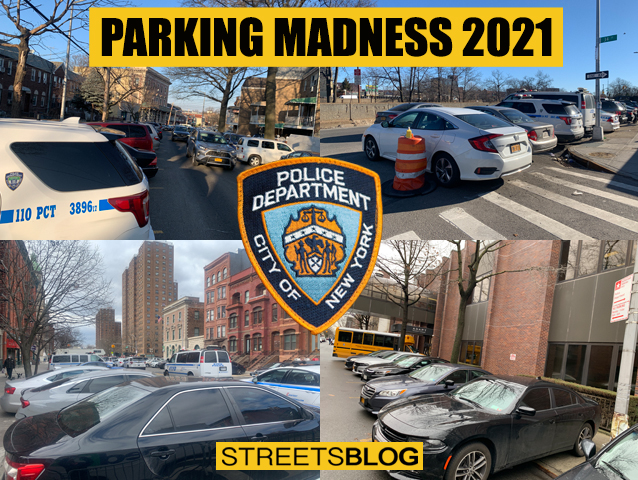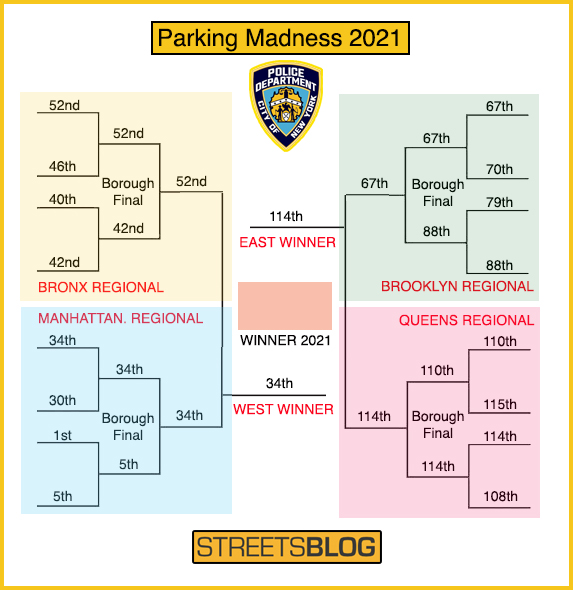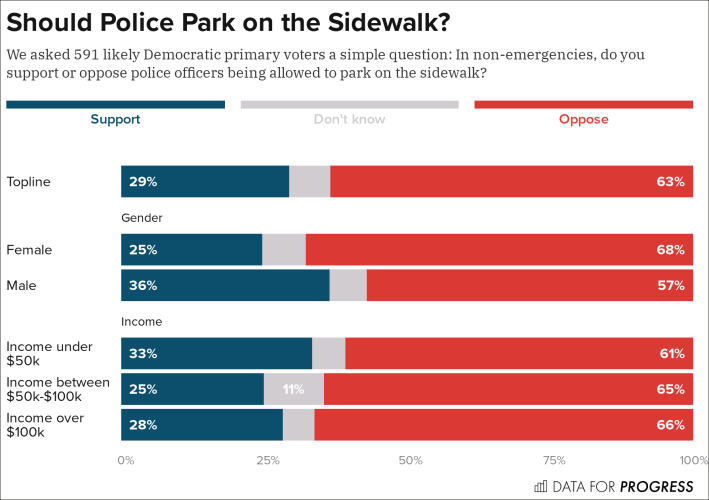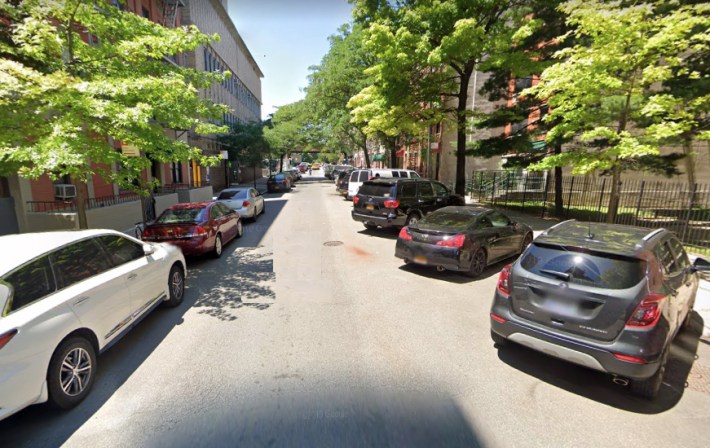MARCH (PARKING) MADNESS: Why We Did This Contest — an Editorial
12:01 AM EDT on April 8, 2021

There are still a few hours left to vote in our March (Parking) Madness contest finale, pitting the NYPD's 114th Precinct in Astoria against the 34th Precinct in Washington Heights. For a recap on how both precincts made it to the final round of a contest devoted to egregious police parking, click here for the 114th recap and here for the 34th recap. The following is an editorial about the serious issues raised by our NCAA-style tournament.
We're on the right side of history.
For the past few weeks, readers of Streetsblog have been enjoying our lighthearted tournament pitting NYPD police precincts against each other to determine which station house treats its residential neighbors with the greatest contempt.

This contempt comes in the form of officers' cars and department vehicles illegally parked, double-parked, foolishly parked or combat-parked in front of the station house or on its residential side streets — a situation that makes many blocks around NYPD station houses chaotic, garbage-strewn, dangerous, and appearing to be occupied by a hostile military force that doesn't care at all about the people around it.
Which, in fact, the NYPD is.
Anyone who walks, bikes or drives in this city has experienced the sudden feeling of menace whenever approaching a New York City station house, thanks to the manner in which police officers commandeer public space with this ongoing hostility. In the course of our tournament, we saw:
- Cops parked in front of fire hydrants.
- Cops triple parked.
- Cops leaving cars in crosswalks, curb cuts and in a way that blocks pedestrians or those in wheelchairs.
- Cops who leave their cars in residents' driveways.
- One block where the police were so aggressive in taking parking from neighbors that residents started deploying their own barricades to block cops from stealing "their" spaces.
Just for fun, here's a slideshow of the worst stuff we saw:
Members of the safe-streets community, which includes activists, journalists and groups such as Transportation Alternatives, have long complained about the middle finger NYPD officers and employees deploy to their neighbors — but we weren't sure if the general public shares our concern about the NYPD's willful appropriation of public space.
So we asked.
Streetsblog's parent company, Open Plans, commissioned a poll last month, which was conducted by the professional firm Data for Progress. Among many questions about our city's dangerous streetscape, we asked: "Should cops be able to park their cars on the sidewalk during non-emergencies?"
The results from the poll of 591 likely Democratic primary voters were clear (margin of error is plus/minus 4 percent):
- 63 percent said they oppose cops parking on the sidewalk.
- Of those, 47 percent were "strongly opposed," while only 15 percent "strongly support" this entitlement for officers.
- Only 30 percent of respondent said they were OK with the practice.
- Women are far more opposed to the practice than men (68 percent opposition compared to 57 percent opposition).
Clearly, the public does not want cops parking on the sidewalk. But let's be clear: The chaos around New York City police precincts is not merely aesthetic or symbolic — it creates a real danger to pedestrians, cyclists and other motorists (and an illegal impediment to people in wheelchairs).

As part of our preparation for this year's contest, Streetsblog undertook an exhaustive review of city crash reports on the blocks near and directly in front of NYPD precinct houses. In many cases, protected or painted bike lanes vanish on the roadway directly in front of a station house, which is entirely a result of the NYPD not supporting the Department of Transportation's efforts to keep cyclists safe.
In other words, a cyclist can be riding, say, westbound on E. 119th Street in Harlem, where there is a painted bike lane and relatively little danger from drivers. When the cyclist crosses Lexington Avenue, the bike lane disappears and suddenly the roadway is filled with dozens of more parked cars, some perpendicular or angled to the sidewalk, some scattered here and there, with squad cars often double-parked in front of the 25th Precinct station house. It's a chaotic mess that leads to crashes. Here's what it looks like:

Yes, it's a mess, but is it more dangerous to drivers and more vulnerable road users? A verifiable yes.
In our study, which covered crashes from from the start of 2018 until the dawn of the pandemic in 2020, we found that on precincts that face a public street:
- 70 precincts had a higher number of crashes on the precinct block than on either of the side streets directly on either side of the station house. Only four precincts in the entire city — the 62nd in Bensonhurst, the 90th in Greenpoint, and the Fifth and 23rd in Manhattan — had fewer crashes on the block in front of the station house.
- The increase in crashes on a precinct block versus the neighboring blocks varies by precinct and borough:
- In Manhattan, the average precinct block had more than double the crashes (118 percent more) than the blocks on either side of the station house.
- In The Bronx, the average precinct block had 75 percent more crashes than the blocks on either side of the station house.
- In Brooklyn, the average precinct block had more than triple the crashes (204 percent more) than the blocks on either side of the station house.
- In Queens, the average precinct block also had more than triple the crashes (232 percent more) than the blocks on either side of the station house.
- Staten Island had similar numbers, but the results were heavily skewed against the NYPD because one precinct block contains a busy supermarket with a large parking lot, and it is likely that the supermarket bears a disproportionate share of the blame for crashes.
The reason there are so many crashes on precinct blocks is simple: There is so much driving to precinct blocks — and so much chaos on precinct blocks. Both are problems that are easily solved, yet neither Mayor de Blasio nor Police Commissioner Shea want to address.
The city would dramatically reduce police officers' driving if the state legislature would require police officers — like other city employees — to live in the five boroughs. But Albany is unlikely to take on the police unions — which cherish the right of tens of thousands of its members to live outside the city — without strong advocacy of the mayor. As a result, a majority of cops live outside the city — and an overwhelming majority of those cops drive to work every day.
Barring that heavy lift, the mayor could simply deny cops parking placards and properly enforce parking rules around station houses so they start to resemble normal city office buildings rather than the filthy frat houses they have become. The police commissioner could also simply order his cops to shape up.
The main problem is that neither the mayor nor Shea believe there is a problem. (That's not a surprise; when Streetsblog spent most of 2019 documenting the poor driving records of NYPD officers, the mayor and Shea mostly shrugged it off and failed to suspend any officer's parking privileges.) When asked about police parking, the mayor has only spoken about the need to create more spaces for cops — which is simply rank foolishness, given that more parking spaces would only encourage more driving and, as we have seen during this tournament, more illegal parking and vehicular bullying.
We asked the NYPD to comment for this story, and Sgt. Jessica McRorie sent over this statement: "Commanding officers at locations across the city are always working to better address this condition."
We have ample evidence that this is not true.
Reminder: there's still time to vote in our March (Parking) Madness contest finale pitting the 114th Precinct vs. the 34th Precinct.
This piece was the work of the Streetsblog staff.
Stay in touch
Sign up for our free newsletter
More from Streetsblog New York City
Friday’s Headlines: Canal Street Follies Edition
Manhattan Borough President Mark Levine isn't happy. Plus other news.
Daylight Again: Bronx Community Board Backs Parking Ban at Intersections
The Boogie Down is down with daylighting!
Community Board Wants Protected Bike Lane on Empire Blvd.
Brooklyn Community Board 9 wants city to upgrade Empire Boulevard's frequently blocked bike lane, which serves as a gateway to Prospect Park.
The Brake: Why We Can’t End Violence on Transit With More Police
Are more cops the answer to violence against transit workers, or is it only driving societal tensions that make attacks more frequent?




